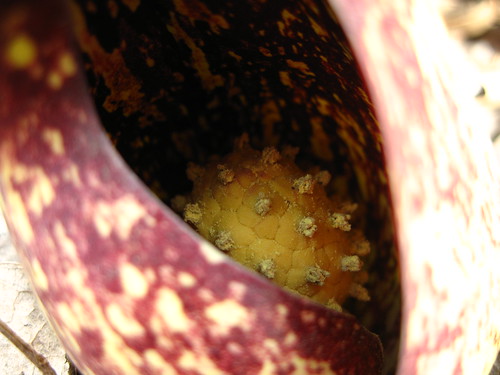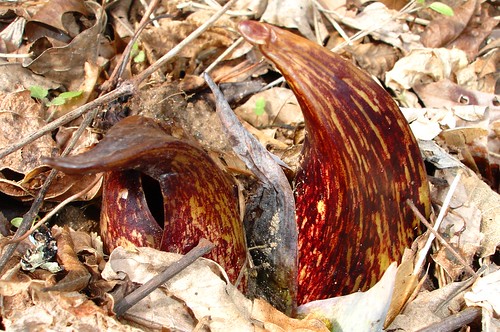If you are afflicted with melancholy at this season, go to the swamp and see the brave spears of skunk-cabbage buds already advanced toward a new year...There is no can’t nor cant to them. They see over the brow of winter’s hill. They see another summer ahead. -- Henry David Thoreau
So much of the diversity in the natural world is the result of plants and animals figuring out how to survive in territory where others can't. A few weeks ago, we talked about rock tripe and how it manages to pluck enough moisture and nutrients from the air that it can colonize rock surfaces. Today, we bring you skunk cabbage -- which not only survives in a wetland environment many plants find inhospitable, but manages to attract pollinators in late winter, when nothing else is flowering.
To attract those pollinators, skunk cabbage relies more on guile than on charm. The skunk cabbage flower is no sweet-smelling bull's eye like most of the flowers we'll see later in the year. In fact, it stinks. Somehow, this plant has figured out how to make the molecules cadaverine (normally put off by rotting flesh) and skatole (otherwise found in scat). And with them, it attracts flies and beetles seeking a meal.
The flowers continue their deception with a streaky reddish-purple spathe (the hood-shaped bract around the flowers) that is not unlike the color of carrion these insects are seeking. Inside that hood is a spadix made up of dozens of flowers, which get inadvertently pollinated by insects seeking a stinky bite to eat.
And skunk cabbage has one more trick up its sleeve (or should we say, spathe). Amazingly, it produces its own heat -- it may be 50 degrees or more above the ambient air temperature when the female flowers are in full bloom. This brings in more insects. For one thing, the warmth makes the stinky carrion smells more volatile. And insects might expect a piece of carrion to be warm, because of the heat released by the bacteria that are breaking it down.
But some insects just seem to want a little vacation from winter, like the rest of us do. Skunk cabbage can be warm enough to melt snow and ice, which surely feels good to insects trying to make a living at this time of year. The flowering season for skunk cabbage can vary by the weather, but in the Washington DC area they can start flowering in January and may go as late as March.
So, if you've been feeling the melancholy of the season, or having trouble seeing the summer ahead...it's a great time to start looking for flowers.
In the wild: Skunk cabbage tends to grow in relatively flat areas that stay wet or muddy for most of the year. Look along small streams and seeps -- perhaps even growing in shallow water. There are many patches of skunk cabbage in Rock Creek Park and lots of other local parks. You may have noticed it in the summer with its large clumps of 2-foot-long leaves growing close to the ground. Right now you won't see much hint of the leaves -- you're just looking for the purplish spathes poking up from the ground.
In your yard: You won't have much luck growing skunk cabbage unless you've got a wetland in your backyard. If you do, go for it -- skunk cabbage are deer resistant, and that foliage is hard to beat.






